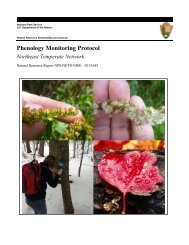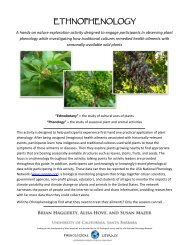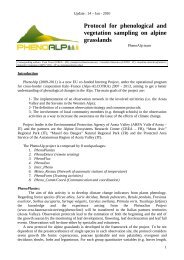The Phenology Handbook - USA National Phenology Network
The Phenology Handbook - USA National Phenology Network
The Phenology Handbook - USA National Phenology Network
You also want an ePaper? Increase the reach of your titles
YUMPU automatically turns print PDFs into web optimized ePapers that Google loves.
PROTOCOLS FOR PHENOLOGICAL MONITORING<br />
INTRODUCTION<br />
All phenological studies share one simple goal: to obtain precise dates of key life cycle events. <strong>The</strong>re is, however,<br />
substantial variation among species in how they complete a given phenophase and this can complicate the process<br />
of identifying and assigning a date for a given phenophase. Consider the date of first flower — does a plant<br />
reach the phase of “first flower” when the petals of its first flower begin to become visible as the bud opens, or is<br />
it when the flower is open enough to see the anthers or stigma inside (the correct answer is the latter)? How do<br />
we determine this phenophase for different species whose flowers open in different ways or at different rates?<br />
Furthermore, not all flowers have the same reproductive structures inside, so our definition of first flower must<br />
also accommodate structural differences among species.<br />
As another example, consider the spatial arrangement — or architecture — of the flowers produced by a plant.<br />
Some plants produce a single flower on each flowering stem whereas others produce loose or dense clusters<br />
(called inflorescences) of a few, of dozens, or of hundreds of flowers per stem. Within inflorescences of some<br />
species, the individual flowers may be so small that even a magnifying glass cannot make them clearly visible.<br />
How, then, should we quantify the date of first flower for a plant whose individual flowers we cannot even see!?<br />
<strong>The</strong> answers to these questions, and many more, are provided in this chapter.<br />
<strong>The</strong> goal of this chapter is to provide definitions of phenophases for flowering plants so that observations can be<br />
standardized among observers. Given the tremendous variation in plant architecture among species, we have<br />
made an effort to facilitate the identification and recording of phenological information. First, we have aimed to<br />
minimize the number of definitions and to present them in a manner that is intuitive to all readers, regardless of<br />
their botanical experience. Second, we have identified several classes of plant architecture, each of which has its<br />
own set of protocols for the rapid identification and measurement of its phenophases. Most species of plants<br />
can easily be assigned to one of these architectural classes, so it will be a simple matter for readers to find the<br />
protocol that is most appropriate for the individual plant or species that they are observing.<br />
<strong>The</strong> methods and definitions presented here have been tested by Stewards in the UCSB <strong>Phenology</strong> Stewardship<br />
Program and we’re confident that, with a little practice, even novices will soon be able to identify the phenophases<br />
of most species that they encounter. In this chapter we will consider general points, such as where and<br />
when to observe plant phenology, as well as specific points such as phenophase definitions by which phenologists<br />
can standardize their observations with other phenologists in the Santa Barbara region and across the country.<br />
PLANT PHENOPHASES<br />
Before we address general points about phenological monitoring such as site and plant selection, we will first remind<br />
the reader about plant phenophases. Although there is considerable variation among flowering plant species<br />
with regard to when and how rapidly seasonal events occur, the generalized plant phenological sequence<br />
can be summarized as follows:<br />
• leaf budburst<br />
• first full leaf (first leaf is fully expanded)<br />
• entire plant leaf-out (all leaves on the plant are expanded)<br />
28










